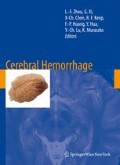Abstract
Introduction
Compared to ischemic stroke, intracerebral hemorrhage (ICH) is easily and rapidly identified, occurs in younger patients, and produces relatively small initial injury to cerebral tissues - all factors suggesting that interventional amelioration is possible. Investigations from the last decade established that extent of ICH-mediated brain injury relates directly to blood clot volume and duration of blood exposure to brain tissue. Using minimally-invasive surgery plus recombinant tissue plasminogen activator (rtPA), MISTIE investigators explored aggressive avenues to treat ICH.
Methods
We investigated the difference between surgical intervention plus rtPA and standard medical management for ICH. Subjects in both groups were medically managed according to standard ICU protocols. Subjects randomized to surgery underwent ste-reotactic catheter placement and clot aspiration. Injections of rtPA were then given through hematoma catheter every 8 h, up to 9 doses, or until a clot-reduction endpoint. After each injection the system was flushed with sterile saline and closed for 60 min before opening to spontaneous drainage.
Results
Average aspiration of clots for all patients randomized to surgery plus rtPA was 20% of mean initial clot size. After acute treatment phase (aspiration plus rtPA), clot was reduced an average of 46%. Recorded adverse events were within safety limits, including 30-day mortality, 8%; symptomatic re-bleeding, 8%; and bacterial ventriculitis, 0%. Patients randomized to medical management showed 4% clot resolution in a similar time window. Preliminary analysis indicates that clot resolution rates are greatly dependent on catheter placement. Location of ICH also affects efficacy of aggressive treatment of ICH.
Conclusion
There is tentative indication that minimally-invasive surgery plus rtPA shows greater clot resolution than traditional medical management.
Access this chapter
Tax calculation will be finalised at checkout
Purchases are for personal use only
Preview
Unable to display preview. Download preview PDF.
References
Abdul-Ghaffar NU, el-Sonbaty MR, el-Din Abdul-Baky MS, Marafie AA, al-Said AM (1997) Stroke in Kuwait: a three-year prospective study. Neuroepidemiology 16: 40–47
Akdemir H, Selçuklu A, Pasaoĝlu A, Oktem IS, Kavuncu I (1995) Treatment of severe intraventricular hemorrhage by intraventricular infusion of urokinase. Neurosurg Rev 18: 95–100
Becker KJ, Baxter AB, Bybee HM, Tirschwell DL, Abouelsaad T, Cohen WA (1999) Extravasation of radiographic contrast is an independent predictor of death in primary intracerebral hemorrhage. Stroke 30: 2025–2032
Broderick JP, Brott T, Tomsick T, Miller R, Huster G (1993) Intracerebral hemorrhage more than twice as common as subarach-noid hemorrhage. J Neurosurg 78: 188–191
Brown RD Jr, Ransom J, Hass S, Petty GW, O’Fallon WM, Whisnant JP, Leibson CL (1999) Use of nursing home after stroke and dependence on stroke severity: a population-based analysis. Stroke 30: 924–929
Caplan LR (1992) Intracerebral hemorrhage. Lancet 339: 656–658
Daverat P, Castel JP, Dartigues JF, Orgogozo JM (1991) Death and functional outcome after spontaneous intracerebral hemorrhage. A prospective study of 166 cases using multivariate analysis. Stroke 22: 1–6
Findlay JM, Weir BK, Kassell NF, Disney LB, Grace MG (1991) Intracisternal recombinant tissue plasminogen activator after aneurysmal subarachnoid hemorrhage. J Neurosurg 75: 181–188
Findlay JM, Grace MG, Weir BK (1993) Treatment of intraventricular hemorrhage with tissue plasminogen activator. Neurosurgery 32: 941–947
Hondo H, Uno M, Sasaki K Ebisudani D, Shichijo F, Tóth Z, Matsumoto K (1990) Computed tomography controlled aspiration surgery for hypertensive intracerebral hemorrhage. Experience of more than 400 cases. Stereotact Funct Neurosurg 54-55: 432–437
Kandel EI, Peresedov VV (1985) Stereotaxic evacuation of spontaneous intracerebral hematomas. J Neurosurg 62: 206–213
Kumral E, Ozkaya B, Sagduyu A, Sirin H, Vardarli E, Pehlivan M (1998) The EGE stroke registry: a hospital-based study in the Aegean region, Izmir, Turkey. Analysis of 2000 stroke patients. Cerebrovasc Dis 8: 278–288
Lampl Y, Gilad R, Eshel Y, Sarova-Pinhas I (1995) Neurological and functional outcome in patients with supratentorial hemorrhages. A prospective study. Stroke 26: 2249–2253
Lippitz BE, Mayfrank L, Spetzger U, Warnke JP, Bertalanffy H, Gilsbach JM (1994) Lysis of basal ganglia haematoma with recombinant tissue plasminogen activator (rtPA) after stereotactic aspiration: initial results. Acta Neurochir (Wien) 127: 157–160
Matsumoto K, Hondo H (1984) CT-guided stereotaxic evacuation of hypertensive intracerebral hematomas. J Neurosurg 61: 440–448
Mayfrank L, Lippitz B, Groth M, Bertalanffy H, Gilsbach JM (1993) Effect of recombinant tissue plasminogen activator on clot lysis and ventricular dilatation in the treatment of severe intraventricular haemorrhage. Acta Neurochir (Wien) 122: 32–38
Miller DW, Barnett GH, Kormos DW, Steiner CP (1993) Stereo-tactically guided thrombolysis of deep cerebral hemorrhage: preliminary results. Cleve Clin J Med 60: 321–324
Mohadjer M, Braus DF, Myers A, Scheremet R, Krauss JK (1992) CT-stereotactic fibrinolysis of spontaneous intracerebral hemato-mas. Neurosurg Rev 15: 105–110
Morgenstern LB, Frankowski RF, Shedden P, Pasteur W, Grotta JC (1998) Surgical treatment for intracerebral hemorrhage (STICH): a single-center, randomized clinical trial. Neurology 51: 1359–1363
Ojemann RG, Heros RC (1983) Spontaneous brain hemorrhage. Stroke 14: 468–475
Rohde V, Schaller C, Hassler WE (1995) Intraventricular recombinant tissue plasminogen activator for lysis of intraventricular haemorrhage. J Neurol Neurosurg Psychiatry 58: 447–451
Schaller C, Rohde V, Meyer B, Hassler W (1995) Stereotactic puncture and lysis of spontaneous intracerebral hemorrhage using recombinant tissue-plasminogen activator. Neurosurgery 36: 328–335
Shen PH, Matsuoka Y, Kawajiri K, Kanai M, Hoda K, Yamamoto S, Nishimura S (1990) Treatment of intraventricular hemorrhage using urokinase. Neurol Med Chir (Tokyo) 30: 329–333
Todo T, Usui M, Takakura K (1991) Treatment of severe intraventricular hemorrhage by intraventricular infusion of urokinase. J Neurosurg 74: 81–86
Tzaan WC, Lee ST, Lui TN (1997) Combined use of stereotactic aspiration and intracerebral streptokinase infusion in the surgical treatment of hypertensive intracerebral hemorrhage. J Formos Med Assoc 96: 962–967
Author information
Authors and Affiliations
Editor information
Editors and Affiliations
Rights and permissions
Copyright information
© 2008 Springer-Verlag
About this paper
Cite this paper
Morgan, T., Zuccarello, M., Narayan, R., Keyl, P., Lane, K., Hanley, D. (2008). Preliminary findings of the minimally-invasive surgery plus rtPA for intracerebral hemorrhage evacuation (MISTIE) clinical trial. In: Zhou, LF., et al. Cerebral Hemorrhage. Acta Neurochirurgica Supplementum, vol 105. Springer, Vienna. https://doi.org/10.1007/978-3-211-09469-3_30
Download citation
DOI: https://doi.org/10.1007/978-3-211-09469-3_30
Publisher Name: Springer, Vienna
Print ISBN: 978-3-211-09468-6
Online ISBN: 978-3-211-09469-3
eBook Packages: MedicineMedicine (R0)

